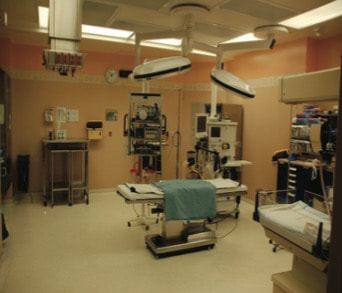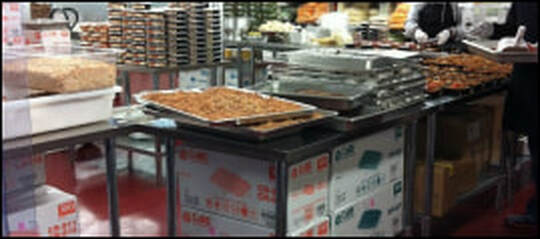Types Of Systems:
Epoxy Coatings
When you are considering a floor coating system, Epoxy tends to be the most popular seamless flooring solution in both the Commercial and Industrial markets.
An Epoxy coating system consists of a polymer and a co-polymer (or a resin and hardener), that when properly mixed together, permanently crosslink and transform from a liquid to a solid...very similar to a hard piece of plastic.
Since it is applied as a liquid and then hardens, it transforms into a seamless, solid material, and is often referred to as "Seamless Flooring". This is an ideal type of floor system for laboratories, clean rooms, restrooms, and kitchens, since there are no places for dirt, germs and bacteria to hide.
An Epoxy coating system consists of a polymer and a co-polymer (or a resin and hardener), that when properly mixed together, permanently crosslink and transform from a liquid to a solid...very similar to a hard piece of plastic.
Since it is applied as a liquid and then hardens, it transforms into a seamless, solid material, and is often referred to as "Seamless Flooring". This is an ideal type of floor system for laboratories, clean rooms, restrooms, and kitchens, since there are no places for dirt, germs and bacteria to hide.
Epoxy offers several advantages as a floor coating system, the most important is Epoxy's natural adhesive properties that allow it to form a tenacious bond to properly prepared concrete. Even customers who are considering a Urethane or other coating system as their "final wear" surface, will elect to go with Epoxy as the "primer", due to it's wonderful adhesive properties.
Epoxy coating systems come in a number of colors and different textures, such as:
* High Gloss
* Orange Peel
OR
* Flat Finish
Epoxy Coating Systems can be
* Water-Based
* Solvent-Borne
OR
* 100% Epoxy Flooring Systems
and can be installed with little or no VOC's (volatile organic content), thereby making them eco-friendly and ideal where people, product and food exposure is present. Inasmuch, there will be no fear of odor contamination or disruption to production in nearby areas.
Epoxy Coating Systems are sometimes loaded with fillers, such as, sand, colored quartz, paint chips, glitter and other innovative ideas in order to produce decorative effects or to simply "spruce up" the coating thickness.
Certain Epoxy Coating Systems are engineered to harden at substantial thickness, which makes them excellent for repairing damaged, existing concrete flooring.
If Epoxies have a disadvantage, it is that they become extremely hard and continue to harden over the life of the coating system. While hardness may seem like a desirable characteristic, Epoxy Coating Systems can be very easy to scratch and chip. Even normal and regular foot traffic on an Epoxy Floor can produce millions of micro-abrasions, which over time, can "dull" and "cloud" the finish...this can cause the floor to look prematurely old and worn. It is primarily, for that reason, most customers and architects choose to topcoat Epoxy with a more "abrasion-resistant" material, such as Urethane, in order to maximize the image and life of the floor.
Although Epoxy is one of the most popular seamless flooring systems we install, beware of a "one-size-fits-all" flooring material. Original Floors works closely with our clients to select a flooring solution to meet their needs, based on their specific environment.
Epoxy coating systems come in a number of colors and different textures, such as:
* High Gloss
* Orange Peel
OR
* Flat Finish
Epoxy Coating Systems can be
* Water-Based
* Solvent-Borne
OR
* 100% Epoxy Flooring Systems
and can be installed with little or no VOC's (volatile organic content), thereby making them eco-friendly and ideal where people, product and food exposure is present. Inasmuch, there will be no fear of odor contamination or disruption to production in nearby areas.
Epoxy Coating Systems are sometimes loaded with fillers, such as, sand, colored quartz, paint chips, glitter and other innovative ideas in order to produce decorative effects or to simply "spruce up" the coating thickness.
Certain Epoxy Coating Systems are engineered to harden at substantial thickness, which makes them excellent for repairing damaged, existing concrete flooring.
If Epoxies have a disadvantage, it is that they become extremely hard and continue to harden over the life of the coating system. While hardness may seem like a desirable characteristic, Epoxy Coating Systems can be very easy to scratch and chip. Even normal and regular foot traffic on an Epoxy Floor can produce millions of micro-abrasions, which over time, can "dull" and "cloud" the finish...this can cause the floor to look prematurely old and worn. It is primarily, for that reason, most customers and architects choose to topcoat Epoxy with a more "abrasion-resistant" material, such as Urethane, in order to maximize the image and life of the floor.
Although Epoxy is one of the most popular seamless flooring systems we install, beware of a "one-size-fits-all" flooring material. Original Floors works closely with our clients to select a flooring solution to meet their needs, based on their specific environment.
Urethane Coatings
Urethane Coatings have been around a bit longer than Epoxy Coatings and although it is an older technology, it is still regarded in the industry as a better-performing "polymer", for it's outstanding abrasion-resistance and gloss-retention.
"Urethane's" are usually more flexible than their more rigid counterpart..."Epoxy" Coatings, and it is it's modest flexibility, that allows it to better absorb shock, while also resist scratching, under normal foot and wheel traffic. This is especially true, if abrasives (such as, sand or metal-shavings), are in contact with the floor surface.
Revolutionary engineering, first utilized by The Pepsi Cola Corporation, to bond the polymer labels to their glass bottles, was later incorporated by The Tennant Company to enhance the bond of their Urethane Coatings to concrete, thereby, allowing for 2 thin coats of Urethane to perform well, under the heaviest traffic conditions. Further engineering by The Tennant Company, produced patented coatings, loaded with ceramic fillers that greatly extended the life span of their Urethane floors...especially under aggressive traffic such as fork-lifts or high-volume foot traffic.
"Urethane's" are usually more flexible than their more rigid counterpart..."Epoxy" Coatings, and it is it's modest flexibility, that allows it to better absorb shock, while also resist scratching, under normal foot and wheel traffic. This is especially true, if abrasives (such as, sand or metal-shavings), are in contact with the floor surface.
Revolutionary engineering, first utilized by The Pepsi Cola Corporation, to bond the polymer labels to their glass bottles, was later incorporated by The Tennant Company to enhance the bond of their Urethane Coatings to concrete, thereby, allowing for 2 thin coats of Urethane to perform well, under the heaviest traffic conditions. Further engineering by The Tennant Company, produced patented coatings, loaded with ceramic fillers that greatly extended the life span of their Urethane floors...especially under aggressive traffic such as fork-lifts or high-volume foot traffic.
Many of our Industrial, Commercial and Airport Hangar Flooring Clients, choose to go with 2 thin coats of our toughest Urethane as their "flooring system", since this is extremely durable, while also being one of our most economic flooring installation choices available to meet their needs.
If there is any "disadvantage" to Urethane Flooring Systems, it is the fact that it must be applied very thinly, or else it will not perform well. For older concrete, showing signs of erosion or impact damage, 2 coats of Urethane will not provide the adequate "repair" needed to achieve a smooth floor. In this scenario, an Epoxy primer is required, since it can be applied at a greater thickness and then, a topcoat of Urethane would be applied as the "final wear" coat. This has proven to be the most requested system by our clients who have older floors.
Urethane coatings offer the highest abrasion-resistance, as well as, excellent color-stability and chemical-resistance... making them the preferred choice, as the seamless floor's "final wear" coat.
Out of our client-base who experience heavy foot-traffic, or wheel-traffic (such as fork-lifts or aircraft), and even little animal paws, the overwhelming majority, have selected poly-Urethane as the "wear-surface".
If there is any "disadvantage" to Urethane Flooring Systems, it is the fact that it must be applied very thinly, or else it will not perform well. For older concrete, showing signs of erosion or impact damage, 2 coats of Urethane will not provide the adequate "repair" needed to achieve a smooth floor. In this scenario, an Epoxy primer is required, since it can be applied at a greater thickness and then, a topcoat of Urethane would be applied as the "final wear" coat. This has proven to be the most requested system by our clients who have older floors.
Urethane coatings offer the highest abrasion-resistance, as well as, excellent color-stability and chemical-resistance... making them the preferred choice, as the seamless floor's "final wear" coat.
Out of our client-base who experience heavy foot-traffic, or wheel-traffic (such as fork-lifts or aircraft), and even little animal paws, the overwhelming majority, have selected poly-Urethane as the "wear-surface".


